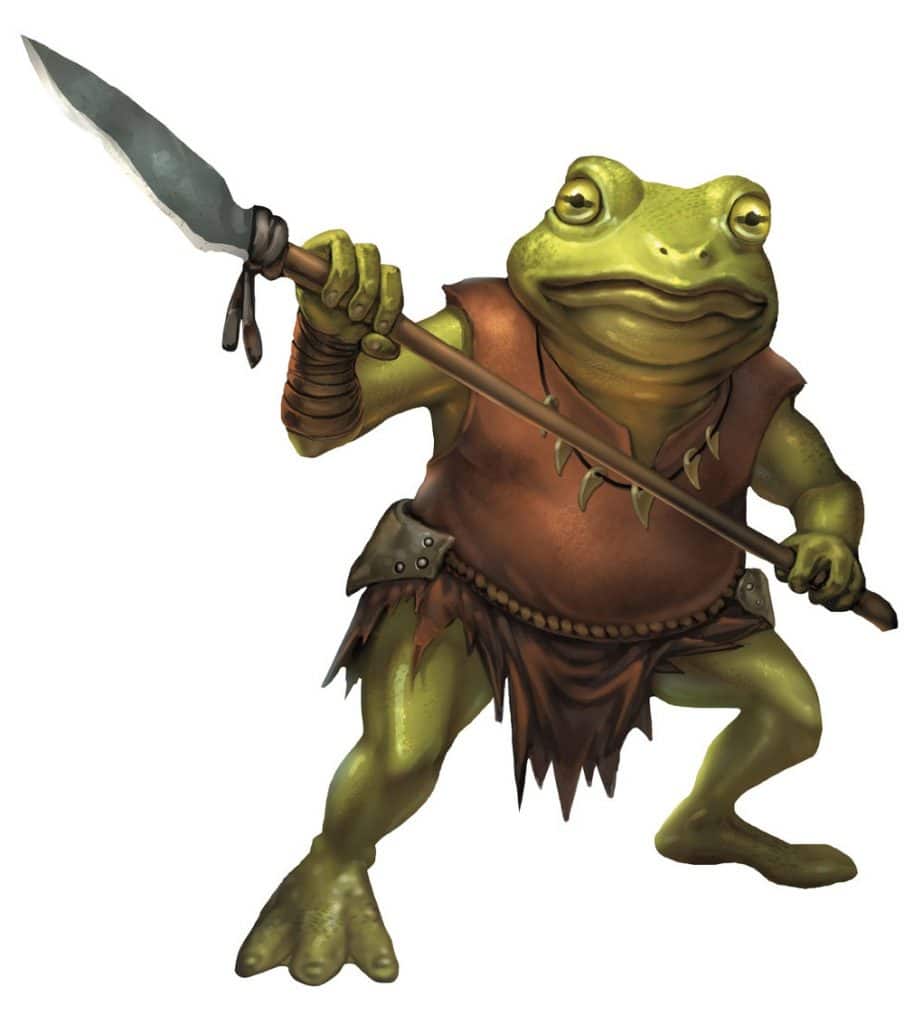Even though no one considers a cockroach to be an intelligent creature, they are still easily smart enough to scatter when a light is turned on. Likewise, while a toddler might not be smart enough to not stick a pea in his nose, he’s still bright enough to realize that screaming will get him Cherrios.
Why? Well, all creatures have instincts. But despite this fact, most D&D encounters simply play monsters interchangeably. Monsters just stand in place for a few rounds while the players stick them full of arrows.
So, let’s look at a few specific D&D monsters and think about what their instincts, ability scores, and alignment–yes, alignment–can teach us about their tactics. Remember, don’t optimize stats; optimize behavior.
 D&D Monsters Tactics
D&D Monsters Tactics

Bullywugs. I written before about how bullywugs should be played like Navy SEALs, so I’ll just sum up here. Bullywugs are squishy and have advantage on stealth checks, so their instinct will absolutely be to attack suddenly and in numbers
The next time players are likely to be traveling through wetland areas, create a really cinematic scene that has hordes of bullywugs rise up from the water having been submerged. You know, like a Navy SEAL would.
Goblins. (See: Paizo.)
Kobolds. Think traps, traps, and more traps. Low CON monsters aren’t going to take PCs on straight, they’ll come in numbers and they’ll use guerrilla warfare. Besides, they eat grubs and stuff. Their motivation is not to hunt PCs like food, they are territorial creatures hoping to protect their eggs.
Like Tunnel Rat, kobolds are excellent tunnelers and are known to create quirky and clever traps. Never allow players to encounter a group of kobolds without first being tenderized a bit through interaction with goofy traps. Turn the entire travel into a hazard. I always think of the movie the Goonies for inspiration.
Constructs. If you are following the HASTE method, a construct is neither Hungry, Angry, Stressed, Tired, nor Elemental. A construct is only motivated by following instructions.
So have those instructions be idiosyncratic. Don’t just have them be ‘attack when anyone enters the room,’ make it be a specific square so if a PC moves, then the construct powers down. Or it doesn’t attack elves or it detects alignment and only goes after the party’s chaotic member or…you get the idea.
Owlbears. With an INT score of 3, owlbears operate under pure instinct. If players enter an Owlbear’s territory, expect hem to get savagely mauled. And have some fun with it as well, if a phrase like “savagely mauled” can ever be fun.
But by that I mean have players hear the owlbear screech from a distance away. A high INT or WIS check lets them know they are being warned away from the territory. That lets players decide if they want to backtrack and circle around or if they are good with traipsing through an Owlbear’s territory.
Orcs. (See HASTE method.)
Lizardfolk. The leaders of a group of lizardfolk will have an INT of 10 or 11, meaning that they are capable of deploying unsophisticated tactics. Use that.
They rarely travel beyond their territory, which makes them extremely xenophobic. They are also superstitious and revere their shamans. So let the shamans cinematically dictate the feel of battle with their fog cloud and entangle spells. Then unleash the bites and claws with the players lacking visibility and mobility.
Dragons. Just two quick things here: 1) they are extremely intelligent, so therefore capable of sophisticated tactics and plans, and 2) they should have distinct personalities.
Undead. The keyword for undead creatures is compulsions. Their tactics and behavior are entirely motivated by their compulsions. So take a moment for each type of undead to think about what they’d instinctively be compelled to do and manage their combat tactics from there.

Yuan-ti. These creatures are devious and wholly uncapable of mercy or compassion. That, and they are also highly intelligent, so therefore capable of planned tactics. Add that up and yuan-ti should be a deadly foe. Every time.
Their suggestion spell should be employed commonly in order to play up their duplicitousness. And any player in trouble should be singled out further to play up their utter lack of compassion.
Giants. D&D giants are structured by the ordning, a caste structure that keeps each type in their place. If the party is fighting giants of different types, remember that whatever trust or bond that brings multiple types of giants together is an uneasy one at best.
So don’t be afraid to have giants turn on one another, even if it is the middle of a combat! If a “lesser” giant sees that players have weakened a giant that is more respected in the ordning, they very well may take advantage of that and make their move.
Otherwise, the lesser giants should be played as brutes. Their intelligence score has them only capable of basic tactics. The exception is cloud and storm giants. Both are 12+ for INT, so therefore capable of advanced strategy.
Oozes. Lacking intelligence, oozes operate fully on the instinct to feed on organic manner. For more on oozes.
Add little bits of flavor to combat, don’t bemoan it. Remember, interesting > deadly. All of the above are well-worn monsters from the Monster Manual.
There are no deep cuts here. But that that doesn’t mean we can’t make them interesting and distinct from one another. Think about their alignment and intelligence scores, then really spare a thought for the instincts that motivate them. because that type of imagination is what makes D&D such a joy to play.

